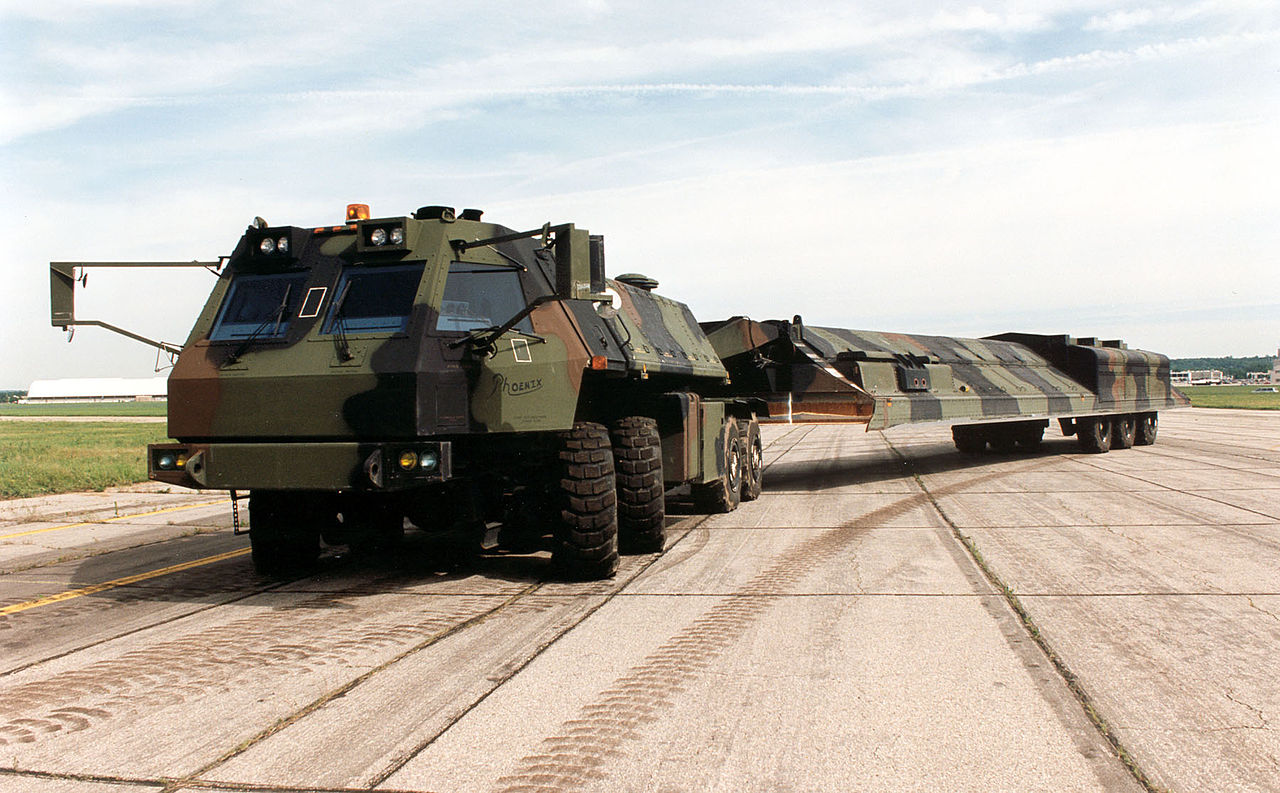
Small ICBM Hard Mobile Launcher at the National Museum
of the United States Air Force.
Martin Marietta-Caterpillar prototype.
Boeing-Goodyear HML launcher during test phase.
This vehicle was the last engineering model, or Engineering
Test Unit, of a mobile, radiation-hardened, truck launcher designed to carry
and launch the MGM-134A Small Intercontinental Ballistic Missile (unofficially
known as the “Midgetman”). It can travel up to 55 mph on the highway,
and it can also travel off the road. The vehicle is capable of using the
trailer-mounted plow to dig the launcher into the earth for additional
protection from a nuclear blast.
Two teams were assigned to develop a vehicle.
Caterpillar developed a tracked tractor (Mobil-Trac System)
while Martin Marietta was the system integrator and also built the Mobility
Test Bed missile trailer.
A second team consisting of Boeing Aerospace and
Electronics’ Loral Defense Systems Division (Goodyear Aerospace) built an eight
wheel drive vehicle and trailer.
The Air Force selected the Boeing-Loral prototype. Several
vehicles were delivered to the US Air Force by December 1986. The Air Force
tested the vehicle until 1991, after which development of the MGM-134 missile
project ceased, leading to the project’s cancellation.
The ETU tractor-launcher combination weighs 239,000 pounds
and has a draw bar pull capability of more than 80,000 pounds. It is powered by
a 1,200-hp Rolls-Royce Perkins diesel engine that drives all eight tractor
wheels through an electro-hydraulic transmission.
The ETU was designed and built by Boeing Aerospace and
Electronics and by Loral Defense Systems Division. It was delivered to the USAF
in December 1988 and tested until 1991 at Malmstrom Air Force Base, Mont.
HML was fantastically expensive. Jan Lodal, in his 1987
article SICBM Yes, HML No, estimated the cost of the Hardened Mobile Launcher
as $30 billion for a force of 500 deployed missiles:
Deploying the SICBM on mobile launchers undoubtedly
improves the missile’s survivability against a large-scale surprise attack.
Mobile launchers would also enhance U.S. ability to respond to a large-scale
Soviet nonnuclear attack with land-based ICBMs, should such a capability become
necessary in the future. But as explained above, making the SICBM mobile
requires buying a hardened mobile launcher (the HML), which will cost about $30
billion. Added to roughly $12 billion for 500 SICBMs, this brings the total
cost of the HML/SICBM combination to a total of $42 billion for 500 deployed
warheads.
Apparently, building a 200,000 pound truck with rad-hard
electronics and capable of withstanding nuclear blast effects is expensive.
Silo-based ICBM advocates today tend to emphasize their role
as warhead sinks — to hopelessly complicate the calculations of an adversary
planning an attack — as well as their relative cost-effectiveness in providing
prompt, flexible target coverage.
Land-mobile ICBMs sacrifice lots of these advantages to basically do the
same things as submarine-launched ballistic missiles, only not as effectively
nor as cheaply (per warhead at the margin.)
The Hard Mobile Launcher was judged too expensive during the
largest peacetime defense buildup in history with the Soviet Union as an
adversary.